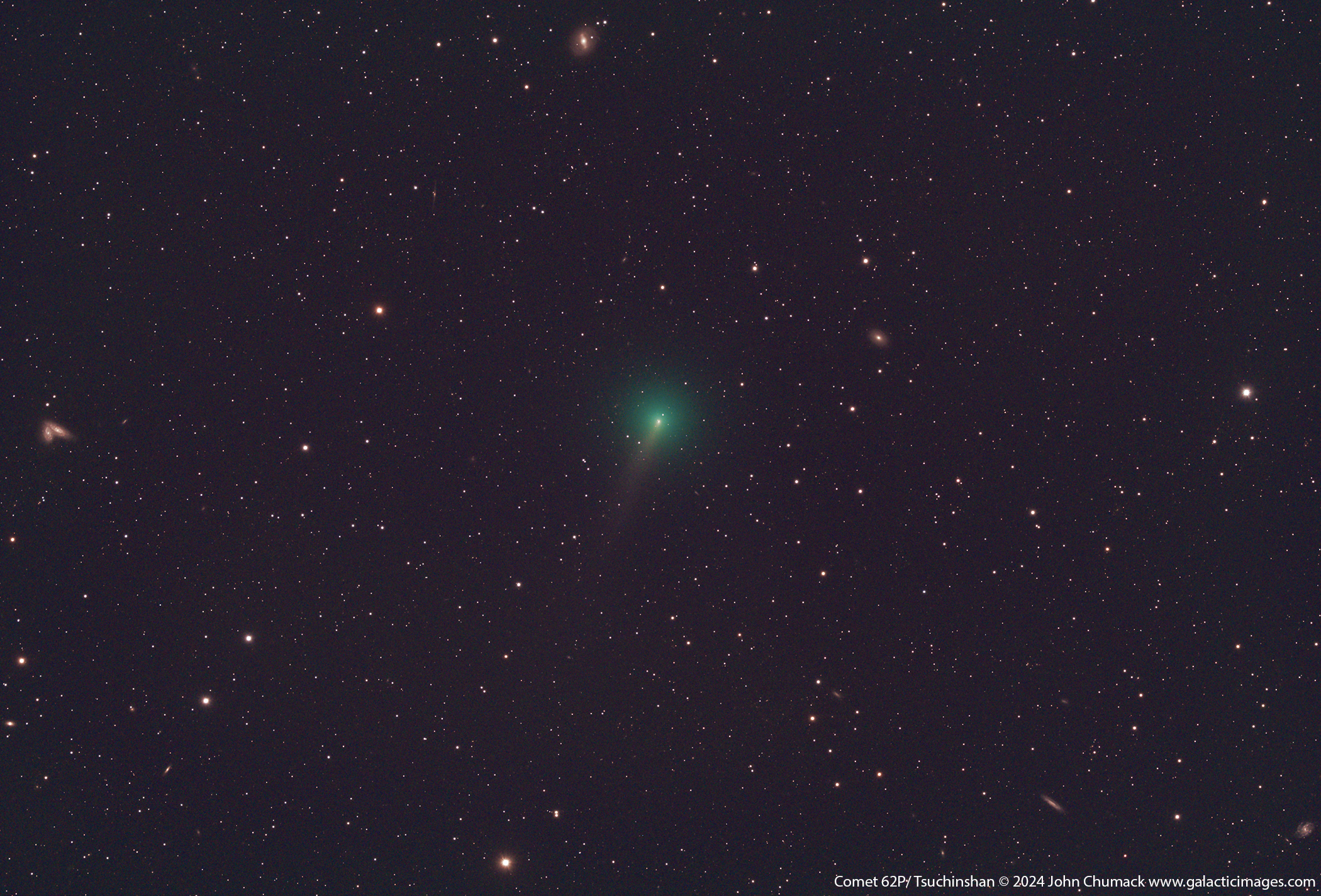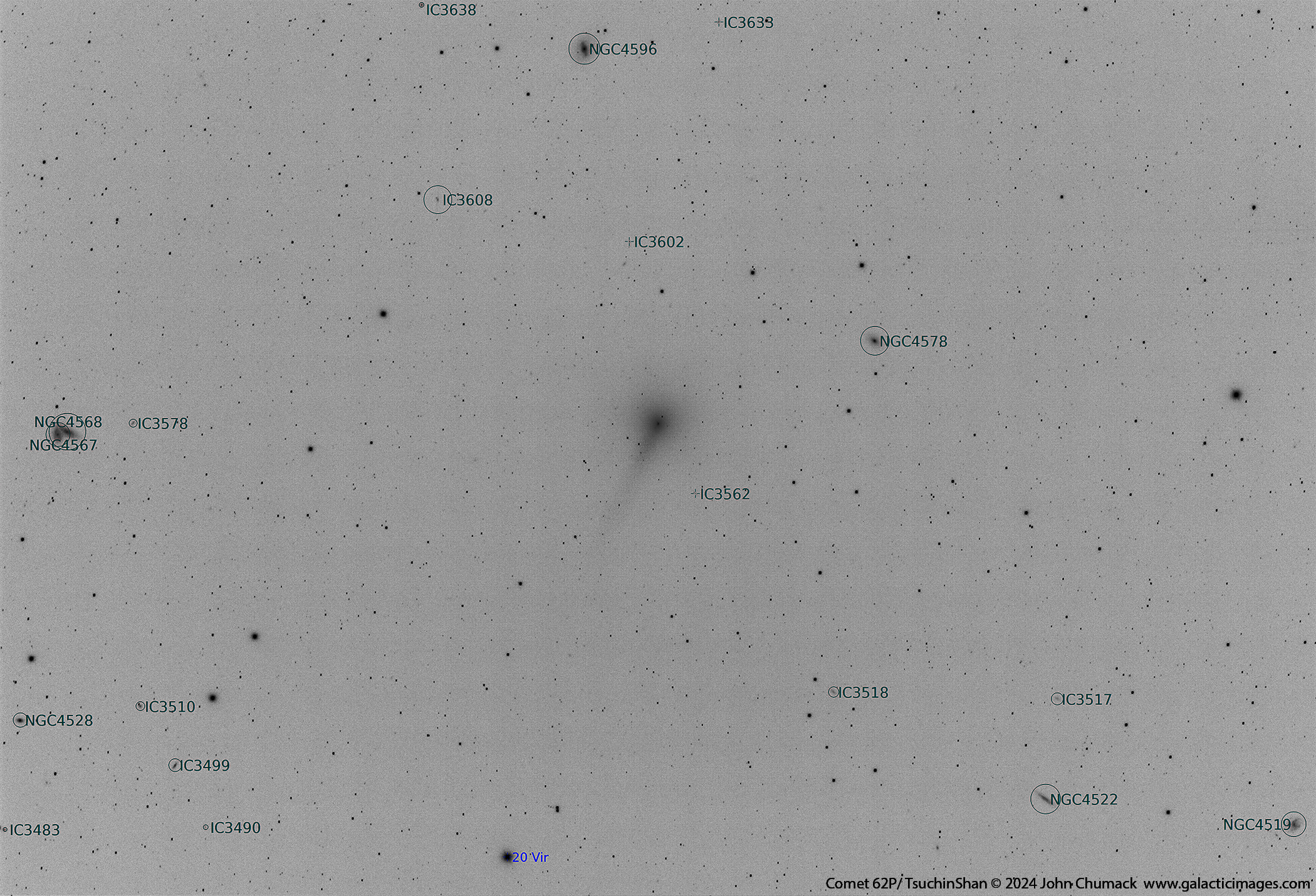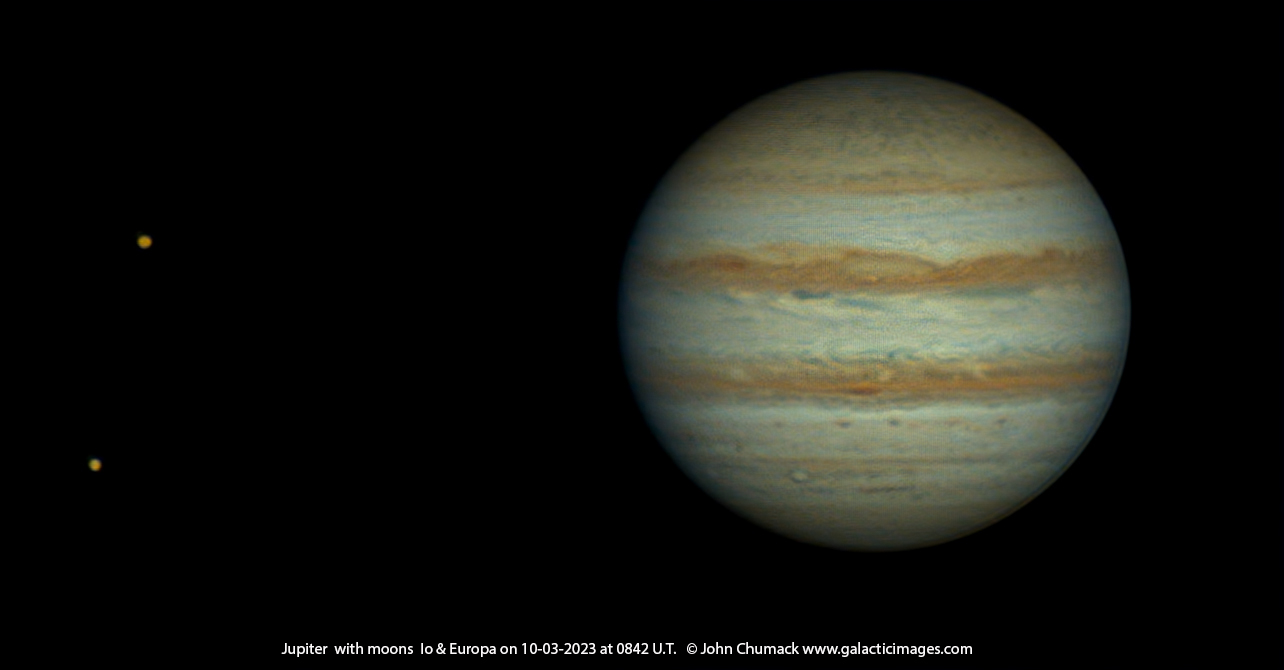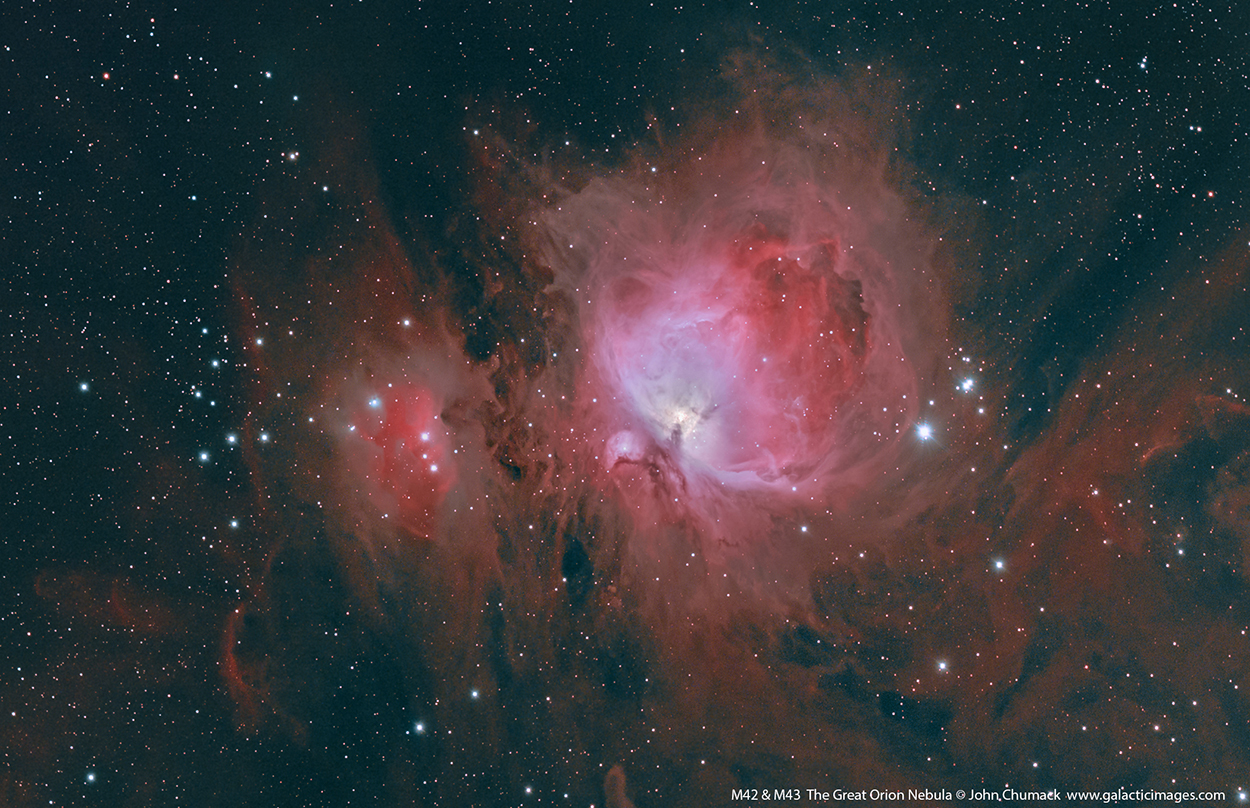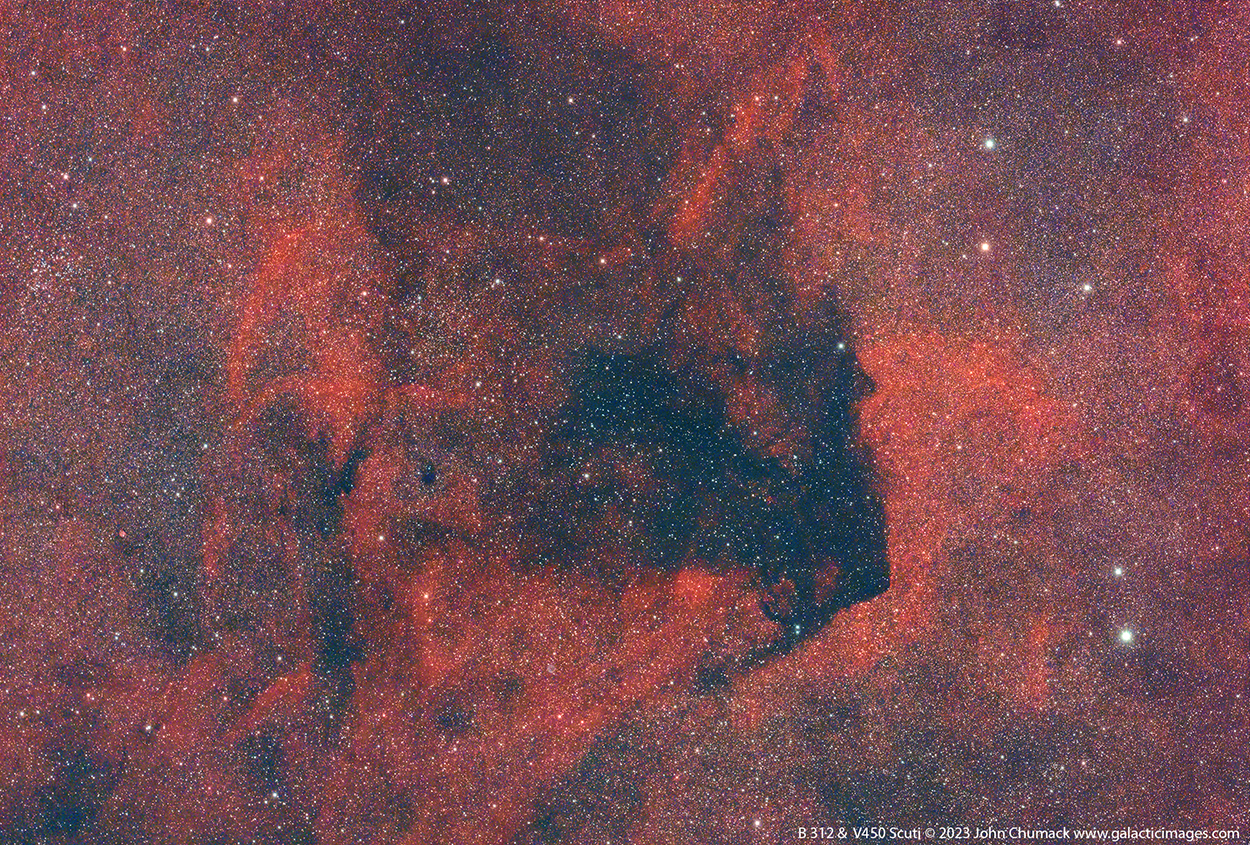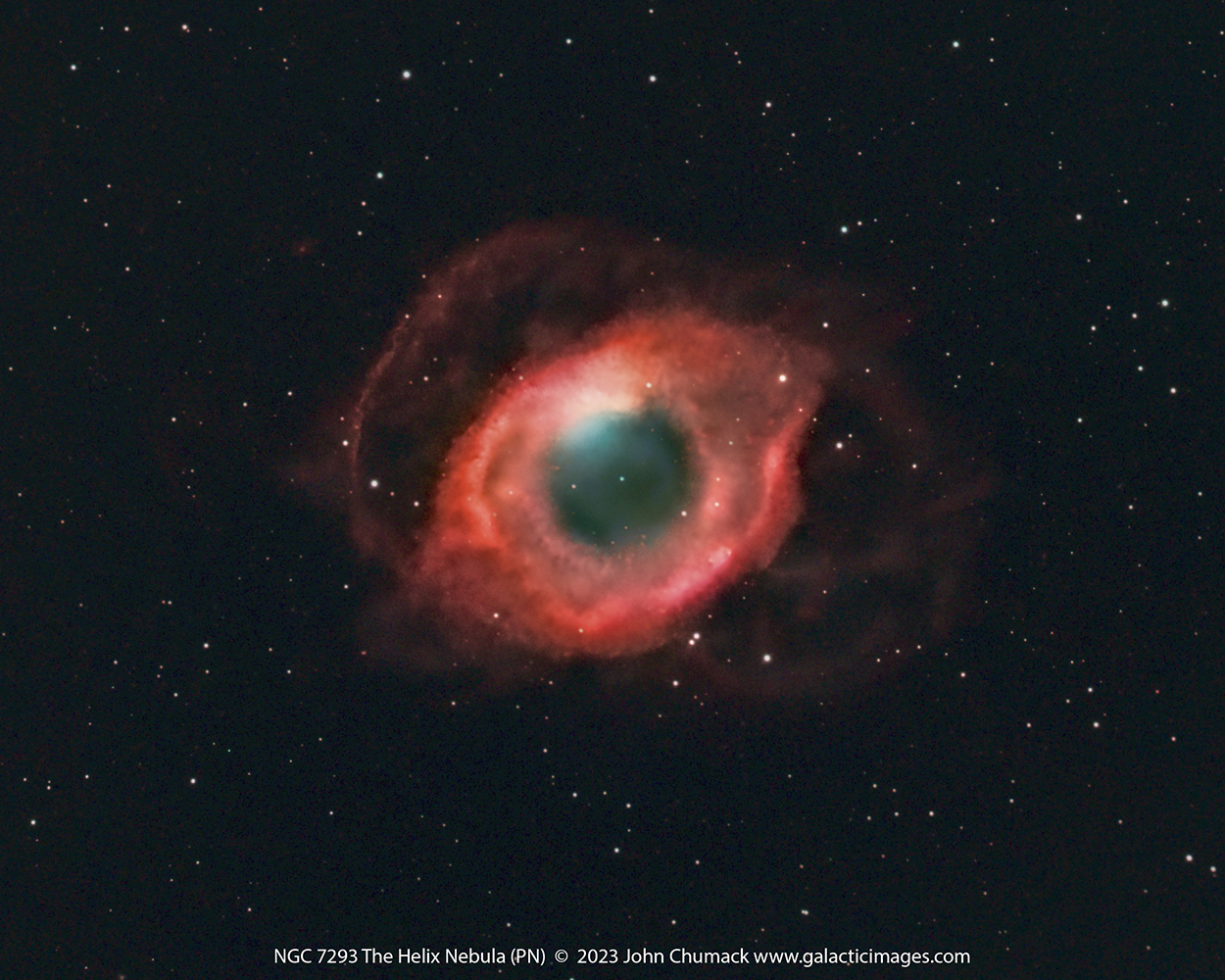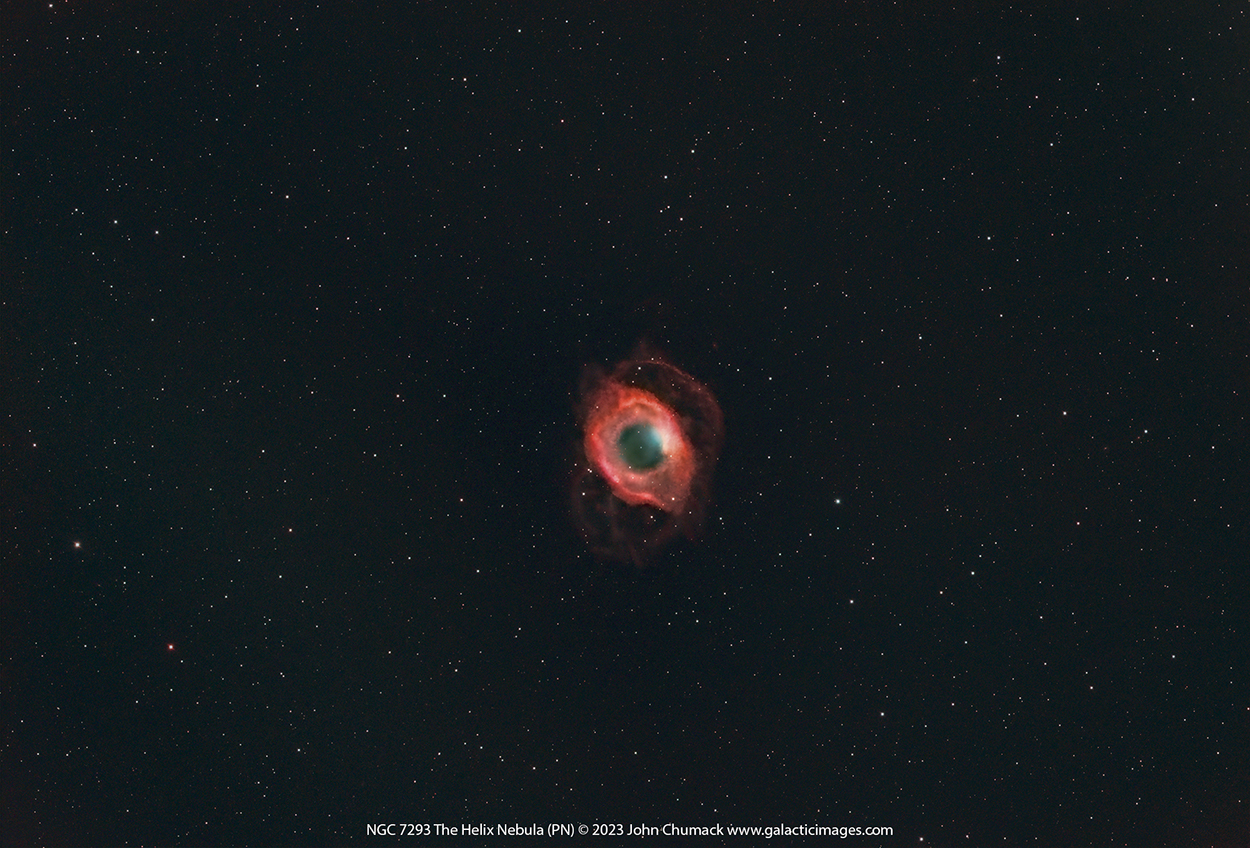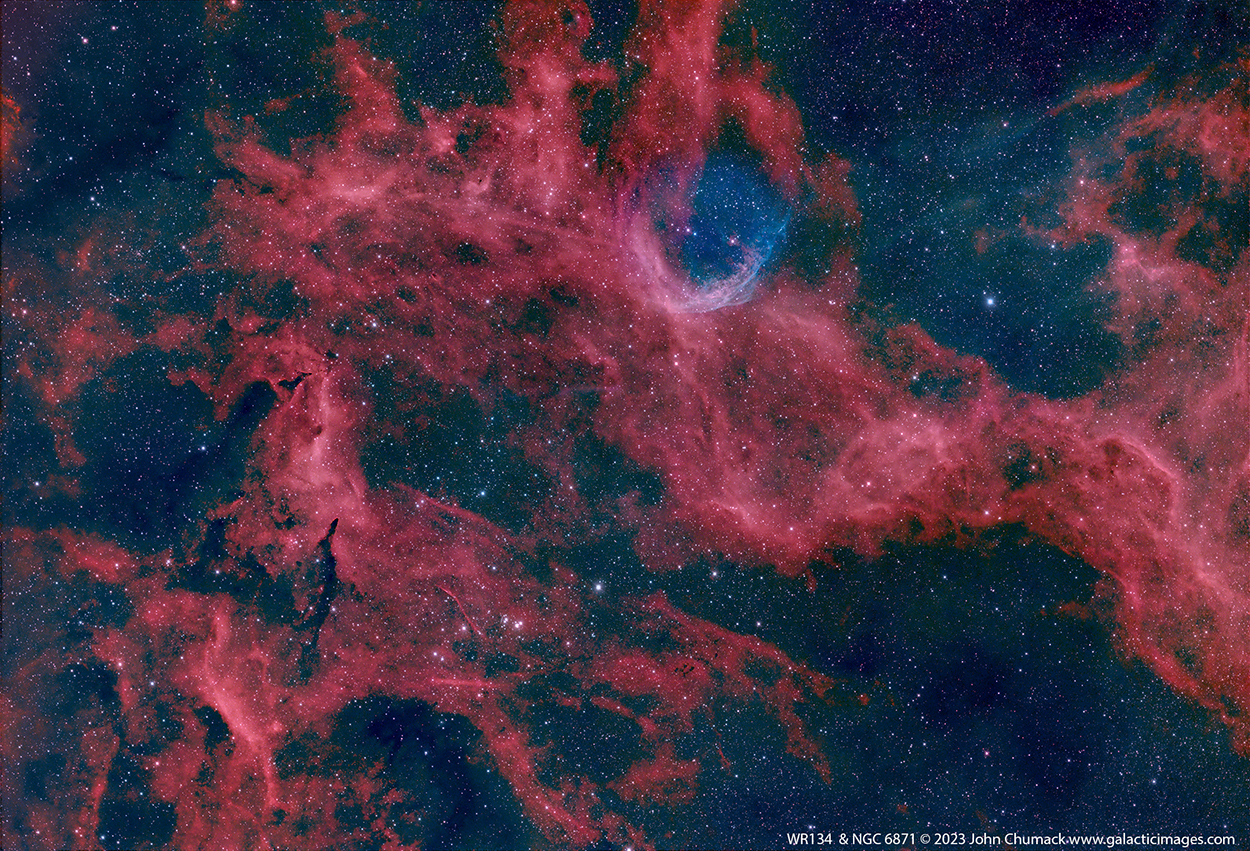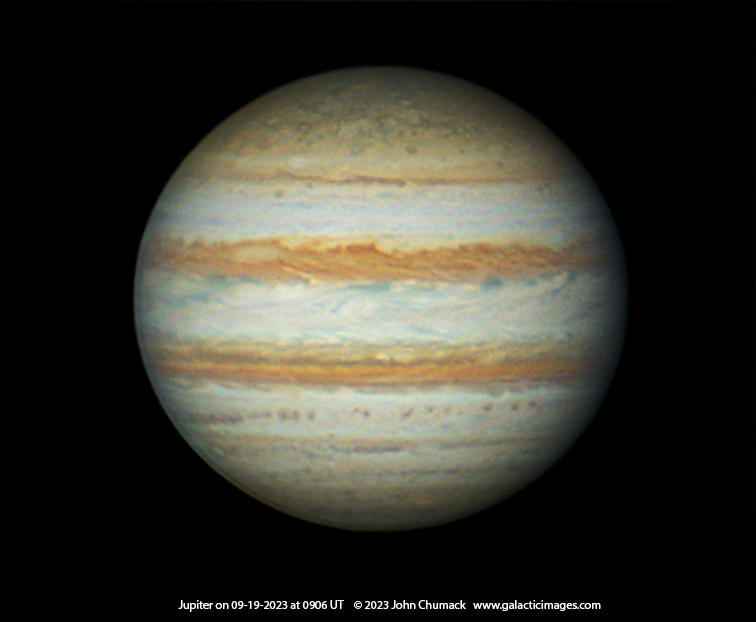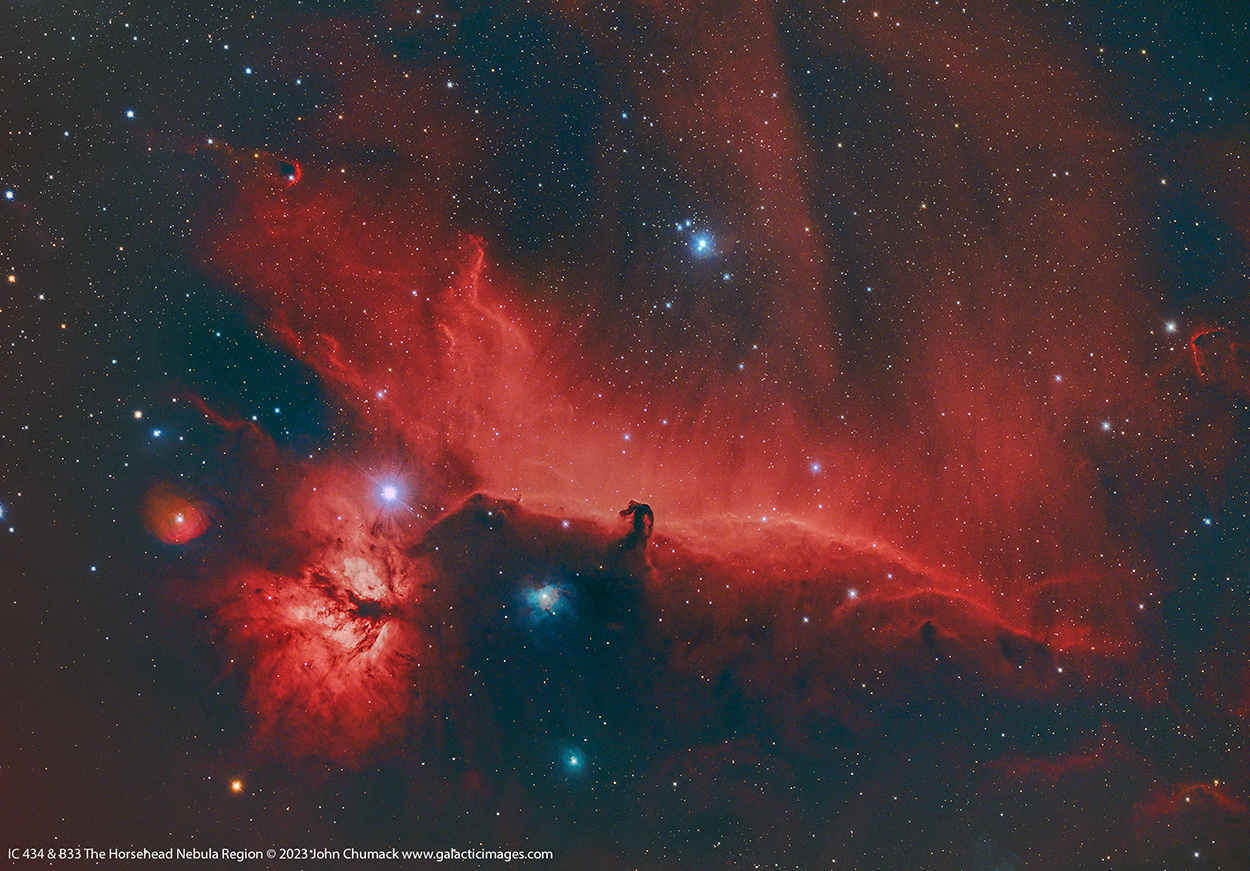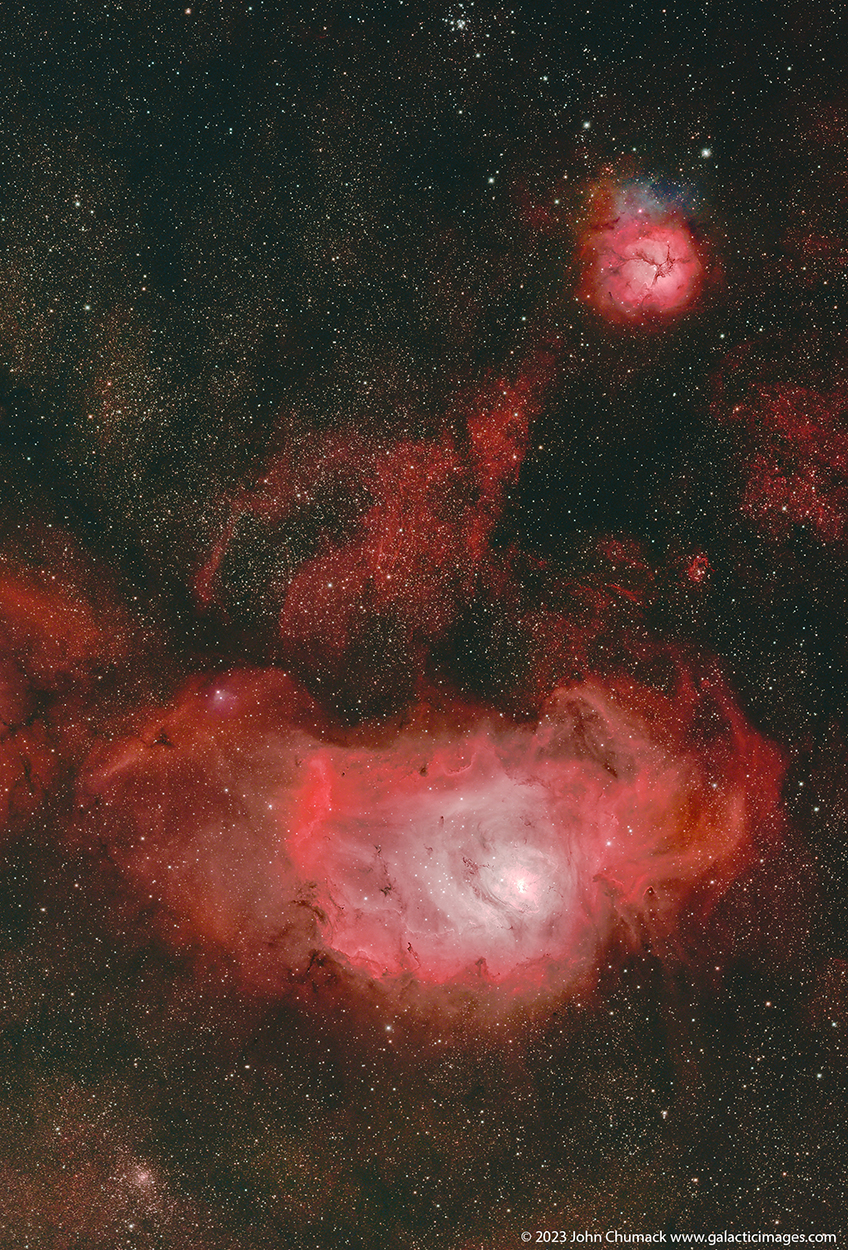Comet 62P/Tsuchinshan with galaxies in Virgo
Comet 62P/Tsuchinshan passing through the background galaxies in Virgo
02-04-2024 (08:24 UT) 03:24 am LT(yes, I pulled an all night run after a month of cloudy weather)
Shining at about 9.2 magnitude and dropping,
you can see the comet with a bright Nucleus, nice green Coma(~8.00′ arc min) and sporting a small dust tail(~12′ arc min) as it passed between The Siamese Twins Spiral Galaxies NGC-4567/NGC-4568 (left edge) and a Lenticular galaxy NGC-4578 on the right.
The background Galaxies are about 55 million light years away, but the comet is relatively close by, actually in our solar system at a distance of 74,850,088 kilometers from Earth.
RASA 8 inch F2 Scope, ZWO 294MC cooled Cmos Camera, AM5 Mount, ZWO L-Quad Band, Filter, EAF, ASI Air Plus,
via Wi-Fi to Ipad, 4 x 300sec subs, 20 minutes total integration time, Stacked DSS, Pixinsight, and Adobe Raw CC 2024.
Captured from my observatories at JBSPO in Yellow Springs, Ohio.
Best Regards,
John Chumack
www.galacticimages.com
The Planet Jupiter with moons Europa and Io on 10-03-2023
Still processing some of my Planet shots from last fall…here is
Jupiter with moons Europa(top) and Io on 10-03-2023 at 08:43 UT
C-11 SCT telescope, F22, Bisque MyT Mount, ADC, 2x barlow, QHY462 un-cooled Cmos camera,
Fire-Capture SER file, stacked 6,750 frames in AS4.
Captured from my Backyard Observatory in Dayton, Ohio USA.
Best Regards,
John Chumack
www.galacticimages.com
The Sword Of Orion – M42, and M43 The Great Orion Nebula Complex
The Sword of Orion
M42 & M43 The Great Orion Nebula Complex
with NGC 1973-75-77 The Running Man Nebula.
I captured some faint background nebulosity and structures as well. This bright nebula is one of the most spectacular views through amateur telescopes! This massive Stellar Nursery is located about 1,350 light-years from Earth.
I finally got around to processing my data from September, and it was a fun challenge to process, due it it high dynamic range, especially at F2, but using layers masking in Adobe CC and carefully combining 3 different exposure lengths, helped me to control the amount of light each layer contributed to the final image.
8″ F2 RASA scope, ZWO AM5 Harmonic Mount, ZWO 294MC cooled Color Cmos camera, Starizona NBZ UHC Filter,
ASI Air Plus via Ethernet to Ipad.
7 x 300 sec., 16 x 30sec, 1 x 10sec sub exposures, 43 minutes and 10 sec. Total integration time.
Stacked in DSS, Processed in Pixinsight and Adobe CC.
Captured from my observatories at JBSPO in Yellow Springs, Ohio on 09-16-2023.
Best Regards,
John Chumack
www.galacticimages.com
Barnard 312 Dark Nebula, V450 Scuti & Gamma Scuti Region
Barnard 312 Dark Nebula (LDN 379) & V450 Scuti & Gamma Scuti Region
Sitting within this incredibly dense sea of stars located in the constellation Scutum,
you can easily see B 312 or Barnard’s Dark nebula in this image, it is so dense it blocks out the light from the background stars.
There are faint wisps of Red Nebulosity located throughout the region as well.
The overall image with the dark nebula looks like a profile of someone looking towards the sky!
Do you see it?
To the upper right is the very luminous Super-giant (Orange/Red) Star known as V450 Scuti. Shining at magnitude 5.47,
V450 Scuti is a naked eye star and can be seen on a clear night without binoculars or a telescope.
It is also a Semi-Regular pulsating variable Star, a W type variable star. (5.42mag to 5.49mag)
Variable stars are stars whose size and/or brightness changes over time. V450 Scuti is located about 2,886.40 light-years (884.96 parsecs) away from Earth.
Gamma Scuti the brightest star in the lower right of my image, has a very interesting future…..
Gamma Scuti, Latin from γ Scuti, is a single, white-hued star.
The apparent visual magnitude of 4.67 indicates this is a dim star but visible to the naked eye.
Based upon an annual parallax shift as seen from Earth, this star is located about 319 light years from the Sun.
Currently it is moving towards our Solar System at 41 km/s, which means in 2.35 million years it will pass at just 20 light-years (5.519 parsecs) distance,
probably becoming the brightest star in the night sky, at magnitude −2.1, for a period.
Celestron 8 inch F2 RASA Telescope, ZWO AM5 Mount, ZWO 294MC Cooled Cmos Camera, Starizona NBZ UHC filter,
ASI Air Plus, via Ethernet to IPAD, 5 x 300sec. subs, 25 minute total integration time.
Capture at my observatories in JBSPO in Yellow Springs, Ohio on 08-19-2023.
Best Regards,
John Chumack
www.galacticimages.com
Partial Solar Eclipse 10-14-2023 Dayton, Ohio
Partial Solar Eclipse from Dayton, despite the clouds and rain.
My Patience & Perseverance paid off!!!
Due to other commitments I did not travel to center-line for this Annular Eclipse…but it didn’t mean I wasn’t going to try to get the partial from home.
I started prepping for the Partial eclipse in my backyard in Dayton about 9:00am this morning, despite the dismal forecast.
I took down my C-11 scope and put my Lunt H-Alpha scope on the MyT mount in the backyard.
I noticed that my neighbor’s tree was blocking the Sun, but I figured in about an hour the Sun would rise high enough to clear the tree.
Luckily by then I managed to get the camera focused on the Sun through some of these large 4 minute gaps in the clouds, I finally got the camera focused and solar tracking locked in by about 10:30am.
Now the waiting game!!! waiting for a sucker hole…Knowing that I will start to see first contact around 11:45am …but only if the gaps in the clouds stayed large
…well go figure…
unfortunately the gaps started getting smaller and far and few between, so I sat with patience and focused on the mission to click that capture button the moment I see the Sun peaking through the thinner clouds. After sitting there and capturing diligently I managed to get 11 good SER captures varying from 3 seconds to 1 minute during the event.
I had to stop at 1:40pm when the rain started and I had to close the dome.
Most of the time I could not even see the Sun’s disk on the PC monitor, until the clouds thinned occasionally, I would raise the camera gain up to help me see it on the monitor better.
A really interesting thing that I noticed while imaging this eclipse during heavy cloud cover was…
I have Solar Panels on my backyard Observatory, and they run fans to cool the observatory, the fans would get louder and faster as the panels get more sunlight,
so as we got small breaks or thinner clouds, I would hear the fans get faster and louder, which cued me to click the capture button as the sun was starting to appear through thinner clouds, and the image would appear on the Computer Screen.
Initially I had trouble stacking the SER video images in Registax6, and Autostakkert3 due to the clouds moving so fast across the frames,
So I switched over to Astrosurface for processing so I could lock in on the Sun’s disk for global stacking, regardless of what the fast moving clouds were doing.
It locked it in and stacked it nice enough for me to post the image. I used 83 good frames from the original 236 SER images file.
It was a little noisy but that was to be expected with such a low amount of frames and shooting through clouds.
I’m so glad I stuck with it despite the conditions, I just kept telling the clouds….you %$#^&*# Resistance is Futile!
I’m happy with the capture!
Capture details:
Lunt 60mm/50F Hydrogen Alpha Solar Telescope, QHY5IIL Cmos Camera, Fire-Capture Software, Sun HA, 1.0ms exposure, Gain 8, 16.5 sec SER file,
Captured from my backyard Observatory on 10-14-2023 16:18 UTC(12:18 Local time).
Best Regards,
John Chumack
www.galacticimages.com
NGC 7293 The Helix Nebula(PN) Close-up _The “Eye of God” Nebula
A nice close-up shot of NGC 7293 The Helix Nebula, also known as the “Eye of God”.
This is a large planetary nebula (PN) located in the constellation Aquarius.
This is a dying star blowing off its outer atmosphere!
Discovered by Karl Ludwig Harding, likely before 1824, this object is one of the closest to the Earth of all the bright planetary nebulae.
Based on recent measured expansion rates this Planetary Nebula is about 10,600 years old.
The central star is destined to become a white dwarf.
The estimated distance is about 215 parsecs (700 light-years). It is similar in appearance to the Cat’s Eye Nebula and the Ring Nebula, whose size, age, and physical characteristics are similar to the Dumbbell Nebula, varying only in its relative proximity and the appearance from the equatorial viewing angle.
This will be the fate of our Sun in about 6 billion years from now!!!
Capture Details:
Celestron RASA 8 inch diameter F2.2 Telescope, ZWO AM5 Harmonic Tracking Mount, ZWO 294MC Cooled Cmos Camera, Starizona NBZ UHS Filter, ASI Air Plus, via Ethernet to I-Pad,
12 x 300 second sub exposures, 60 minute total integration time from my observatories at JBSPO in Yellow Springs, Ohio.
The first image is a 70% Crop Close-up from my original wide field shot. One of my best shots of the Helix to date.
Best Regards,
John Chumack
www.galacticimages.com
WR134 Wolf-Rayet Star & NGC 6871 Open Star Cluster in Cygnus
NGC 6871 Open Star Cluster & WR 134 Wolf-Rayet Star with a beautiful section of Nebula In Cygnus.
I really like the structure and dark nebula in this region as well.
NGC 6871 is a small, young open cluster in the constellation of Cygnus. The cluster has fewer than 50 members,
most of which are blue and white stars. It is located 5,135 light-years from Earth. NGC 6871 was born in the same
giant molecular cloud with at least six other open clusters.
WR 134 is a variable Wolf-Rayet star located around 6,000 light years away from Earth in the constellation of Cygnus,
surrounded by a faint blue bubble nebula blown by the intense radiation and fast wind from the star. It is five times the radius of the sun, but due to a temperature over 63,000 K it is 400,000 times as luminous as the Sun.
WR 134 was one of three stars in Cygnus observed in 1867 to have unusual spectra consisting of intense emission lines rather than the more normal continuum and absorption lines.
These were the first members of the class of stars that came to be called Wolf-Rayet stars (WR stars) after Charles Wolf
and Georges Rayet who discovered their unusual appearance.
WR 134 is classified as an Algol type eclipsing variable and given the designation V1769 Cygni, but the variation is not strictly periodic and brightness changes occur on timescales of hours to days.
Capture details:
Celestron RASA 8inch F2.2, ZWO AM5 Harmonic Mount, ZWO 294MC cooled Cmos Camera, Starizona NBZ UHS Filter, ASI Air Plus via Ethernet to IPAD.
24 x 300 sec. Subs, 120 minute total integration time.
Captured from my observatories at JBSPO in Yellow Springs, Ohio on 09-16-2023.
Best Regards,
John Chumack
www.galacticimages.com
Jupiter on 09-19-2023
Jupiter on 09-19-2023
I got up at 4:00am this morning to get a close-up image of Jupiter while it was nice and high in the sky.
it turned out the seeing was decent for a change. I got some nice Jovian cloud top details!!!
Target=Jupiter, Date: 190923, Time: 090647 UT,
Mag: -2.73, Diameter: 46.32″, Res: 0.10″, Az: 197.30, Alt: 64.44,
Phase: 0.99, CM: CMI=163.7° CMII=290.0° CMIII=315.7°,
Camera: QHY5III462C, Scope: C-11, FL: 6150mm, F-ratio: 21, 2x Barlow + ADC,
Fire-Capture Software, 2.8ms exposures, 60sec. SER Video File, Best 70% of 13,546 frames.
Observer: John Chumack, Location: Dayton, Ohio, Comment: very stable seeing for about 1.5 hours
Seeing: 7/10.
Best Regards,
John Chumack
www.galacticimages.com
IC 434 & B33 The Horsehead Nebula Region on 09-16-2023
IC 434 & B33 The Horsehead Nebula Region on 09-16-2023. Put it up full screen to see the details in the nebula clouds. Reminds me of Aurora curtains coming off the dusty mountain beside the horsehead.
The Horsehead nebula is one of the most Identifiable objects in the sky photographically,
but being so faint it is visually challenging for the human eye to see through a telescope, unless under truly dark skies.
IC 434 & B33 (Barnard 33) the dark horsehead is part of a larger molecular cloud region in Orion. This massive star formation region is about 1,500 light years from Earth.
Captured with my RASA 8 inch F2.2 Telescope, AM5 Harmonic Drive Mount, ZWO 294MC Cooled Cmos Camera, ASI Air Plus via Ethernet to I-Pad,
Starizona NBZ UHS Filter, 12 x 300 sec. subs, 60 minute total exposure integration time.
Captured at my observatories at JBSPO in Yellow Springs, Ohio on 09-16-2023. One of the clearest and transparent nights we had in over a year.
Best Regards,
John Chumack
www.galacticimages.com
M20 The Trifid and M8 The Lagoon Nebulae in Sagittarius (08-18-2023)
M20 The Trifid and M8 The Lagoon Nebulae in Sagittarius,
You need to put this up full screen to see the details!!!
M20 The Trifid Nebula(Top) (catalogued as Messier 20 or M20 and as NGC 6514) is an H II region located in Sagittarius.
It was discovered by Charles Messier on June 5, 1764. Its name means ‘divided into three lobes’.
The object is an unusual combination of an open cluster of stars; an emission nebula (the lower, red portion),
a reflection nebula (the upper, blue portion) and a dark nebula (the apparent ‘gaps’ within the emission nebula
that cause the trisected appearance; these dark bands is also designated Barnard 85). This is a very beautiful example of an
Emission & Reflection Nebulae combination.
The Large bright Orange/Pink nebulae near the bottom in this image is M8 The Lagoon Nebulae Complex.
Easily visible to the naked eye from a dark location.
M8 looks great in binoculars or any small telescope, with the most apparent or easily visible is the bright star cluster
and nebulae center.
The Lagoon Nebula (catalogued as Messier 8 or M8, NGC 6523, Sharpless 25, RCW 146, and Gum 72) is a giant interstellar cloud
in the constellation Sagittarius. It is classified as an emission nebula/H II region.(star formation regions)
The Lagoon Nebula was discovered by Giovanni Hodierna before 1654 and is one of only two star-forming nebulae faintly visible
to the eye from mid-northern latitudes. Seen with binoculars, it appears as a distinct oval cloud like patch with a definite core.
Within the nebula is the open cluster NGC 6530.
The Lagoon Nebula is estimated to be about 4,100 light-years away from the Earth. In the sky of Earth, it spans 90′ by 40′,
which translates to an actual dimension of 110 by 50 light years. Like many nebulae, it appears Red/ pink/orange in time-exposure color photos
but is gray to the eye peering through binoculars or a telescope, due to human vision having poor color sensitivity at low light levels.
The nebula contains a number of Bok globules (dark, collapsing clouds of proto-stellar material), the most prominent of which have
been catalogued by E. E. Barnard as B88, B89 and B296. It also includes a funnel-like or tornado-like structure caused by a
hot O-type star that emanates ultraviolet light, heating and ionizing gases on the surface of the nebula. The Lagoon Nebula also
contains at its center a structure known as the Hourglass Nebula.
Although The Lagoon Nebula is a pretty bright nebula, and can be glimpsed near urban areas as a faint fuzzy patch of light,
to really appreciate & enjoy it at its best try to look at it under nice dark skies away from cities or towns!
Want to see more than your eye shows you???
Then try binoculars or a small telescope, or even better yet try to photograph it,
as long exposures photos will always show you more than the human eye can see.
What I really like about this image is the wealth of detail visible in both nebulae, and especially the Dark Nebulae.
Also at the very top edge of the image is M21 Open star cluster, and at the bottom edge is the Globular star cluster NGC 6544.
Captured Details:
Celestron RASA 8 F2.2 Telescope, ZWO AM5 Mount, ZWO 294MC Cooled Cmos Camera, ZWO ASI Air Plus,
via Wi-Fi to I-Pad, 10 x 300 second subs, 50 minute total exposure time.
Captured on 08-18-2023 from my observatories at JBSPO in Yellow Springs, Ohio.
Best Regards,
John Chumack
www.galacticimages.com


